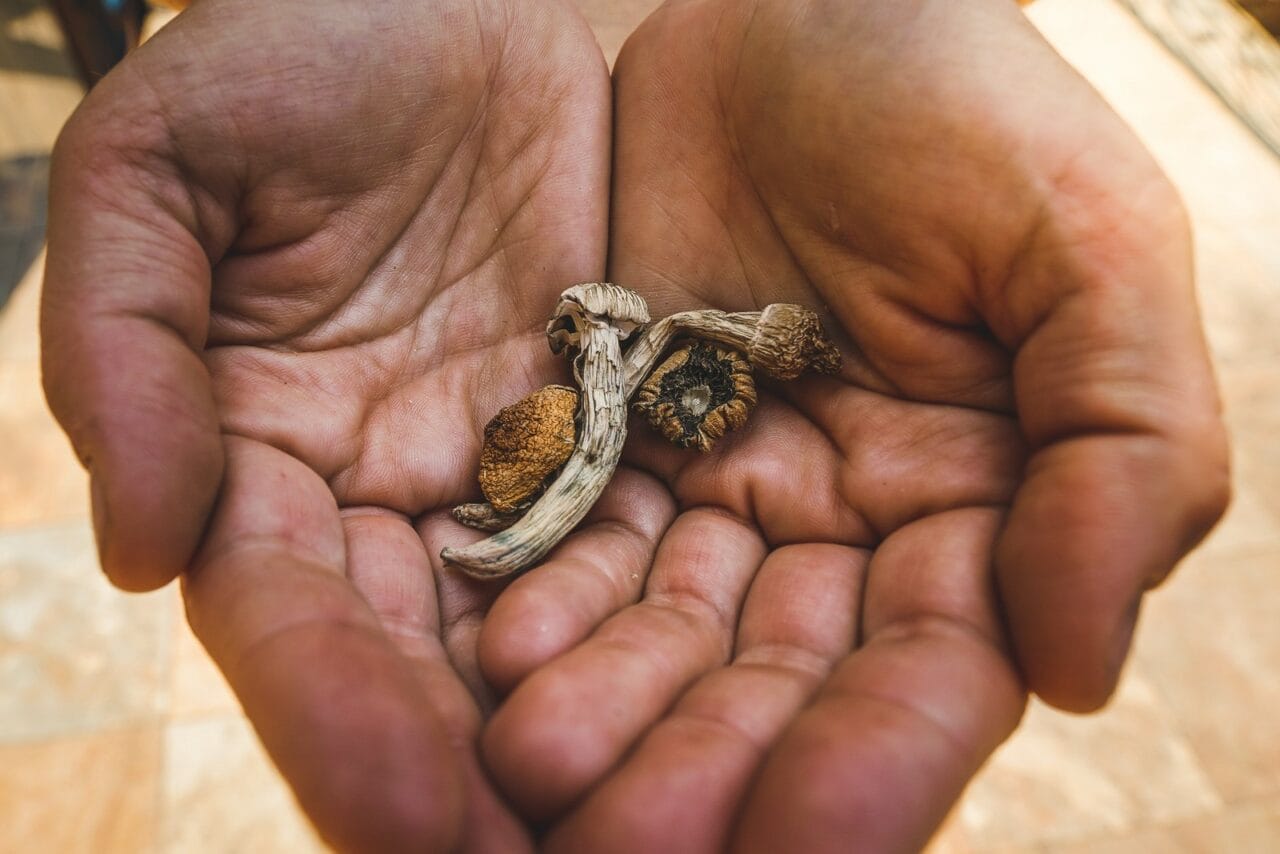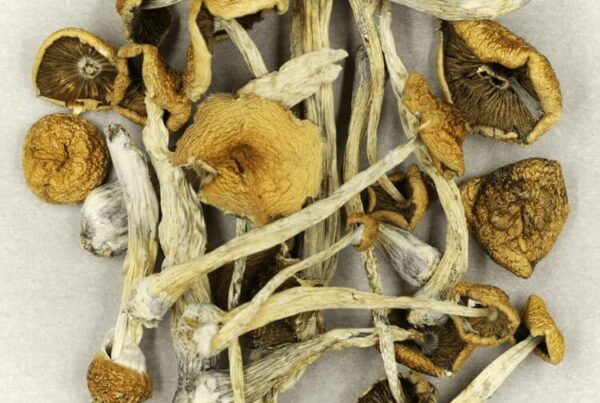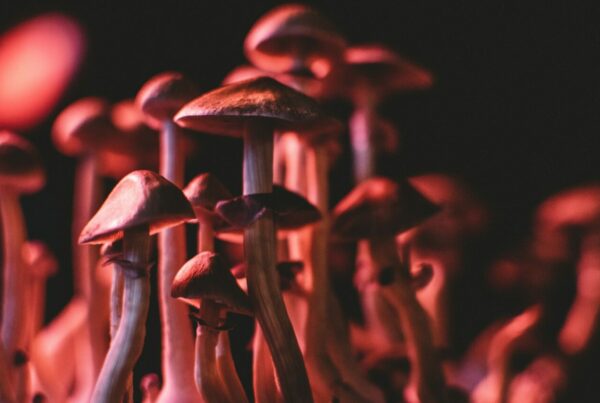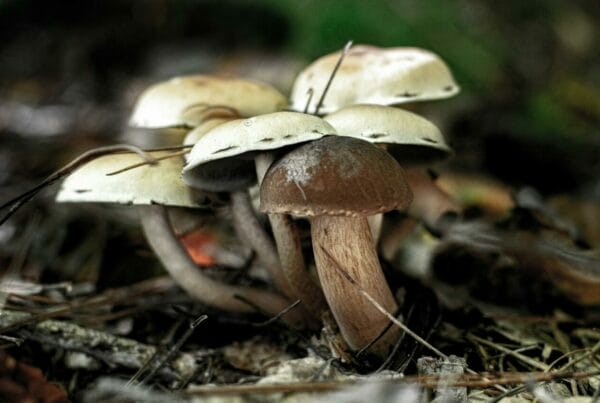Dried mushrooms are among the most sought-after psychedelics available today. If you’ve been contemplating trying them but are unsure if they’re the right fit for you, you’re not alone.
It’s not uncommon for beginners to feel uncertain about which psychedelic to try first. Our goal is to help you understand how dried mushrooms stand apart from other substances and why they could be an excellent starting point for your initial psychedelic experience.
[toc]Key Insights:
- The primary component in Psilocybe, is the most extensively studied psychedelic for mental health due to its safety, minimal potential for misuse, and brief duration of effects.
- The most common form is dried Psilocybe, offering maintained potency and extended shelf life.
- Psilocybin activates the serotonin 5-HT2A receptor, leading to heightened perception, vivid imagery, complex hallucinations, and time distortions.

Psilocybin Mushrooms: An Exploration of Psychedelic Fungi
Psilocybin mushrooms contain the psychoactive substances, psilocybin and psilocin, which are responsible for the hallucinogenic effects users experience. The best-known species—Psilocybe cubensis—features a light brown cap, dark spots, and a distinctive shape. Several other species within the Psilocybe genus also produce these compounds.
Some poisonous mushrooms that carry harmful toxins resemble Psilocybe, which is why we recommend against foraging for mushrooms yourself.
Historically, many mushrooms played a significant role in Central American spiritual practices. Today, their potential in treating mental health disorders, including substance abuse, is being explored by researchers.
Preparation and Preservation: The Dried Variety
The most accessible form of Psilocybe is the dried variety. Dehydration is key to preserving potency and extending shelf life. Fresh mushrooms are typically dried using a food dehydrator or left on a wire rack in a cool, dry environment.
This process is essential for removing excess
Drying Magic mushrooms is critical for their preservation as it prevents the accumulation of moisture, which could stimulate mould growth and lead to the deterioration of the active compounds. Once dried, these mushrooms can be effectively stored for future use.
Here is a comprehensive guide on how to properly dry and store magic mushrooms:
- Initially, dry the mushrooms effectively using a suitable food dehydrator or a wire rack.
- Preserve them in airtight containers to safeguard their potency and shield them from excessive moisture.
- Store them in a location that’s cool and dry to maintain their psychoactive properties.
- Avoid exposing them to direct sunlight to prevent degradation.
- Inspect them regularly for mould or dark spots, which are indications of spoilage.
Comparison of Psilocybe Cubensis with Other Psychedelics
Beyond dried mushroom products, there are a variety of other psychedelic products available online. These substances provide diverse effects on the body and can be used in different ways. Some of these substances are categorized as classic hallucinogens, akin to psilocybin.
| Substance | Origin | Physical Effects | Research Indications | Duration |
| Psilocybin | Occurs naturally in over 200 mushroom species | Augmented perception, hallucinations, altered sense of time | Depression, Anxiety, PTSD, OCD, Cluster headaches, Alzheimer’s disease | 4-6 hours |
| DMT | Naturally present in plants like Psychotria viridis | Intense spiritual experiences, visions, auditory hallucinations | Depression, Addiction | 15-30 minutes |
| LSD | Synthetic, first manufactured by Albert Hofmann in 1938 | Intensified emotions, altered perception, auditory and visual hallucinations | Depression, Anxiety, Addiction, Cluster headaches, Alzheimer’s disease, Tourette’s syndrome, ADHD | 8-12 hours |
| MDMA | Synthetic, synthesized initially by Anton Köllisch in 1912 | Increased release of serotonin, dopamine, norepinephrine, and possibly oxytocin | PTSD, Autism spectrum disorder, Obesity, Narcolepsy, ADHD | 3-6 hours |
| Ketamine | Synthetic, first synthesized by Calvin L. Stevens in 1962 | Anesthetic, induces psychedelic effects at high subanesthetic doses | Depression, Bipolar disorder, Anxiety, Suicidal ideation, Addiction, Autism spectrum disorder, Chronic pain, Arthritis, Fibromyalgia | 1-3 hours |
How Does Your Body Respond?
The operative mechanisms of each substance are conjectural and based on observed outcomes. These hypotheses give some understanding of how these substances may yield their effects, but they don’t provide a concrete comprehension of the underlying processes at work.
- Psilocybin: Effortlessly stimulates the serotonin 5-HT2A receptor, resulting in heightened perception, vivid imagery, detailed hallucinations, and temporal distortions. It also initiates changes in thalamic gating and augments prefrontal cortex activity.
- DMT: Its interaction with serotonin receptors is just a component of its overall impact, the totality of which remains undefined. Even though the serotonin receptor is significant, it doesn’t fully account for all the effects of DMT.
- LSD: It functions within the serotonergic system in the Dorsal Raphe, binding to the 5-HT2A receptor as a partial agonist and the 5-HT1A receptor as a full agonist.
- MDMA: Creates an immediate sense of gratification by facilitating the release of dopamine and serotonin.
- Ketamine: Its exact method of action is undetermined. Its antidepressant effect might be derived from blocking NMDA receptors on neurons, but the selective inhibition of NMDA receptors on GABAergic interneurons and the suppression of AMPA receptors could also be involved.
What Are the Effects of Psychedelic Mushrooms?
The psychological and physical reactions can vary significantly based on factors like dosage, environment, and the individual’s mental state. Common experiences associated with psychedelic mushrooms use include:
- Visual and Auditory Hallucinations: Users may discern patterns, colors, and shapes that do not actually exist.
- Distorted Sense of Time: Time may seem to either elongate or shrink.
- Altered Perception: Sensory experiences may be intensified or distorted.
- Emotional Variability: A wide range of emotions, from happiness to apprehension, may be felt.
- Spiritual Insights: Experiences of a spiritual or mystical kind may occur.
- Physical Effects: These can include an increase in heart rate and blood pressure, as well as feelings of nausea.
Shrooms are generally considered safe when used responsibly. However, without proper preparation, some users might have unpleasant experiences. While seasoned users may find larger doses beneficial, beginners attempting to consume significant amounts may experience a “bad trip.”
Managing your experience with this substance is straightforward. Choose a peaceful, quiet environment and have a sober “trip guide” on hand for assistance.
A Preferable Choice over Other Substances
Dried shrooms are often preferred by medical professionals due to their lengthy shelf life and straightforward dosage. Their shorter duration and easier-to-control intensity make them an ideal option for those new to psychedelic therapy. They are also more natural than other synthetic hallucinogens, with DMT being the only exception.
It can be challenging to distinguish the benefits of different compounds since many clinical studies produce similar outcomes, particularly between LSD and psilocybin. The latter is the most extensively researched psychedelic for mental health issues, largely due to its excellent safety record, low abuse risk, and short-lived perceptual trips.
Health Advantages
- This natural compound can help reduce “cognitive rigidity,” lessen self-destructive thoughts, and encourage self-compassion.
- A study in 2022 discovered that a single 25 mg dose could reduce depression scores in individuals with treatment-resistant depression. Another study in 2023 reported significant and long-lasting reductions in depressive symptoms when using regulated substances in combination with psychotherapy.
- A 2022 clinical trial found that psilocybin-facilitated psychotherapy significantly reduced the number of heavy drinking days over an eight-month period compared to a placebo.
- A 2017 study published in the American Journal of Drug and Alcohol Abuse revealed that two to three doses, in conjunction with cognitive behavioural therapy (CBT), enabled 10 out of 15 participants to abstain from smoking for one year.
- In a pilot study published in Biological Psychiatry in 2022, four out of five patients with anorexia reported improved eating disorder symptoms after a single dose of shroom combined with psychotherapy. Two of these patients also saw a reduction in their anxiety levels.
- Preparation Phase: This phase includes one or more sessions that can last between 1-6 hours each. Conducted with a facilitator, these sessions are meant to address your concerns, define your goals, and set clear expectations to create a safe and trustful environment.
- Dosing Phase: Spanning 5-8 hours, this phase involves you lying down with an eye mask on, listening to a preselected playlist. A therapist will be with you throughout the entire experience.
- Integration Phase: Comprised of follow-up meetings, this phase is designed to help you understand and make sense of your experience. These sessions are spread over several meetings, each lasting a few hours.
Is buying shroom products more economical than other compounds?
When compared to LSD products, dried mushrooms are noticeably cheaper. For instance, you can buy 3.5 grams for about $20. Conversely, the cost of LSD in gel tabs varies depending on the dosage. For example, six tabs with a strength of 100 micrograms each might cost approximately $90.





